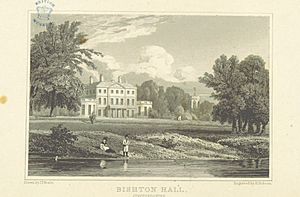John Sneyd facts for kids
John Sneyd (born 1734, died 1809) was an important English landowner. He lived at Bishton Hall and Belmont Hall in Staffordshire. In 1763, he was the High Sheriff of Staffordshire, a special local official. John Sneyd was also well-known in Lichfield. He was interested in plants, farming, and planting many trees.
Contents
A Life of Learning and Land
John Sneyd was the second son of William Sneyd. His mother was Susanna Edmonds. John's father died in 1745. John went to the Middle Temple in 1747 to study law. He then studied at Brasenose College, Oxford, from 1752 to 1756.
His older brother, William Hedges Sneyd, passed away in 1757. John then became the heir to his family's estates.
Working with Famous People
In 1768, John Sneyd visited Shugborough Hall with Joseph Banks. They explored the area around the River Trent. Later that year, Banks went on James Cook's first voyage around the world. Before he left, Banks trusted John Sneyd to look after his collection of dried plants, called a herbarium.
Developing His Land
John Sneyd sold his Bishton estate to focus on his land at Onecote. He also sold some land in Warwickshire in 1776. An enclosure act for Ipstones was passed in 1777. This law allowed him to fence off moorlands.
At Belmont, John Sneyd created huge tree plantations. He won medals from the Society of Arts for his tree planting. He planted about 13,000 larch trees between 1784 and 1786. He even wrote a paper about planting larch trees in 1798.
A Friend of Thinkers
John Sneyd was a friend of Erasmus Darwin, a famous scientist and doctor. Sneyd was a founding member of the Derby Philosophical Society in 1783. In 1792, he helped present a petition against slavery. Many members of the Society, including Darwin, signed it.
John Sneyd passed away at Belmont Hall on December 9, 1809.
Interests and Contributions
John Sneyd was very interested in farming and plants. He added many notes to a book about farming in Staffordshire. This book was called A General View of the Agriculture of the County of Stafford. He also helped write An Arrangement of British Plants (1796) by William Withering.
Family Life
John Sneyd was married three times. His first wife was Penelope Kynnersley. They had ten children together. One of their sons, Thomas, later became Thomas Sneyd-Kynnersley.
In 1794, John Sneyd married his third wife, Mary Adey. She was a friend of the famous writer Samuel Johnson.


